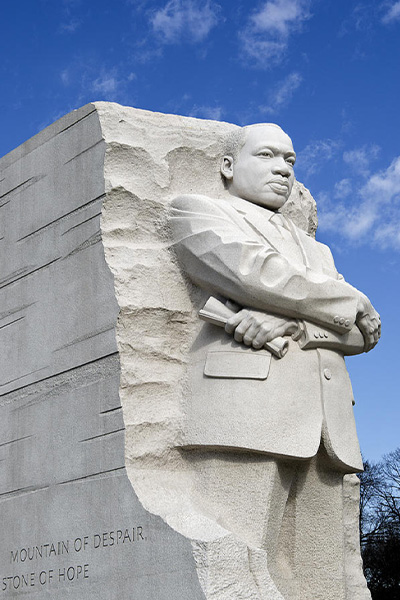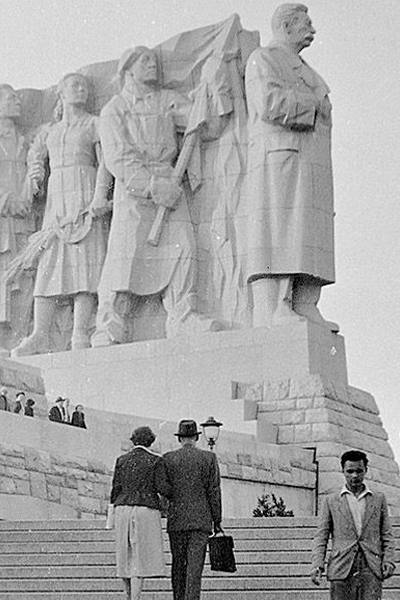“This and That” is an occasional series of paired observations. See past “This and That” posts here. – Ed.
Today: State memorials dedicated to larger-than-life leaders carved from the front of a massive block of white granite
In a state memorial, a larger-than-life leader looks out from the front of a massive block of white granite.
Both the 2011 Martin Luther King Jr. National Memorial in Washington, D.C. and the statue of Stalin that overlooked Prague from 1955 to 1962 meet this description. Read the stories of each, below.
Martin Luther King Jr. National Memorial, Washington, D.C.
The memorial, designed by San Francisco-based ROMA Design Group, features MLK on the front of the proverbial “stone of hope.” Behind it sits the “mountain of despair,” two additional large blocks of granite with a gap between them that visitors pass through to get to the figural part of the memorial.
The 30-foot-tall monument on the National Mall was carved by Chinese sculptor Lei Yixin (雷宜锌), whose previous works include a large-scale sculpture of Mao Zedong.
Considered alongside the Prague Stalin, the sculptures’ similarity seems to be partly due to a socialist visual language the works’ respective sculptors shared. Indeed, the U.S. Commission of Fine Arts originally sought to edit the MLK memorial’s design, because, as commission secretary Thomas Luebke said in an April 2008 letter, “the colossal scale and Social Realist style of the proposed statue recalls a genre of political sculpture that has recently been pulled down in other countries.” But after much public discussion, including defenses of MLK’s “confrontational” pose, the design was approved in September 2008.
It now attracts millions of visitors, but the memorial’s material remains a source of controversy. Although the granite is technically “shrimp pink” and was selected in consultation with the King family, memorializing a Black man in white stone felt, to many, like it missed the mark.
Stalin, Letná Park, Prague, CZ (1955-1962)
Today, the statue of Stalin that once loomed over the Czech capitol at 51 feet tall is remembered as a part of the totalitarian Communist tragedy the nation endured in the bleak 1950s. Its destruction (which was ordered by Moscow after Kruschev denounced Stalin’s reign), is remembered as part of the process of moving on, but as the story is told throughout Prague and in the Czech National Museum today, it first destroyed the life of its creator. When the monument was commissioned, all the region’s artists were required to submit designs. The winner, Otakar Švec, died by suicide before the work was unveiled, rumored to have been horrified by his monument and the terrible conditions in the work camps where it was constructed.
Whereas the rest of the park surrounding King’s memorial in D.C. highlights his famous and inspiring words, Stalin, in his monument, was flanked by workers who were on a scale equal to himself. The workers are a common Soviet design choice, which nods to the ideals of equality Stalin claimed, if not practiced, but some Czechs came to describe the composition as a group queuing for meat, sarcastically pointing back to the food insecurity that marred Stalin’s rule.
Since 1991, a large red metronome designed by Vratislav Novák has sat on the hill from which the stone Stalin briefly observed the city, ticking as time passes, and as one regime changes to another.
*************
No matter how original, innovative or crazy your idea, someone else is also working on that idea. Furthermore, they are using notation very similar to yours. – Bruce J. MacLennan




